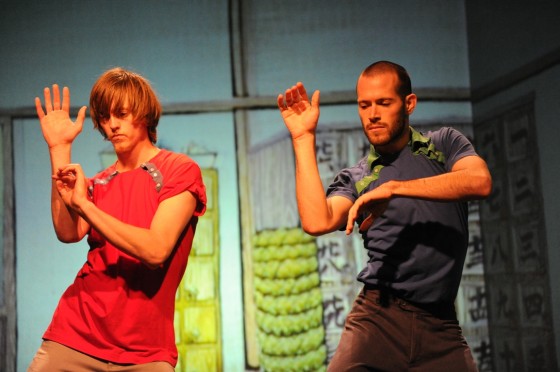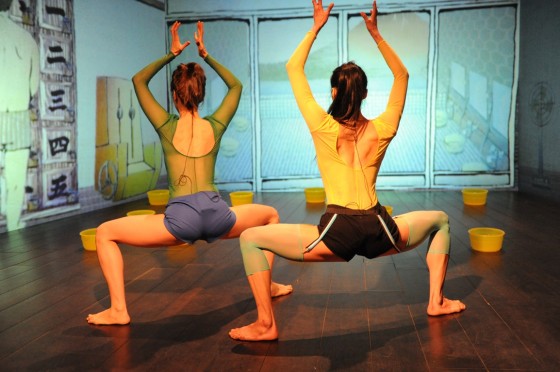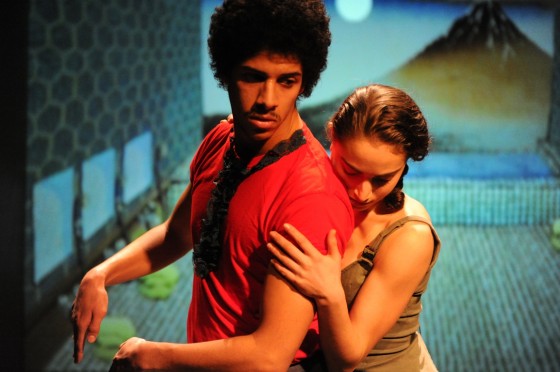Batsheva Dance Company: Ohad Naharin & Tabaimo’s “Furo”
Video: Excerpts of Ohad Naharin & Tabaim’s Furo, performed by the Batsheva Dance Company.
Nearly four years ago, I saw Furo – a collaboration between choreographer Ohad Naharin and video artist Tabaimo – when it was performed at Tel Aviv’s port. Now Furo is back at Batsheva Dance Company’s Studio Varda in the Suzanne Dellal Centre from March 15-26.
Furo fascinated me in 2008, spurring me to write two posts at the time: one after attending the press conference and one after watching the performance on the day of its Tel Aviv premiere. Both of my reflections are below, and ticket information for the current run of Furo is at the end of the article.
* * *

Batsheva Dance Company in Furo. Photograph by Gadi Dagon.
The text below was originally published as “Moving Forward with Ohad Naharin’s ‘Furo'” on The Winger on May 14, 2008.
A question was asked in Hebrew, restated in English, and then translated into Japanese. This was part of the scene at yesterday’s press conference for Furo, a collaboration between Ohad Naharin and the Japanese video artist Tabaimo.
In the last two decades, Israeli choreographers – led by Naharin – have pushed the boundaries of their art form along with their foreign counterparts. Furo continues this move forward. Globalization, collaboration, installation, technology, and video art are some of the hot words right now, and every one of these terms can be used in a discussion about Furo.
The seed for the production began in New York City, where Naharin saw an exhibition of Tabaimo’s Japanese Bathhouse, and the collaboration between the Israeli choreographer and the Japanese video artist was initially shown in Stockholm. Now the installation – with Tabaimo’s video projected onto three screens which shape a stage space dotted with yellow buckets and flanked by two dancers standing on boxes with rotating platforms – is in Tel Aviv.
Over the next few weeks, audiences will flock to the city’s port to see the work, which loops continuously for several hours nearly every day. Viewers can filter in and out as they like; meanwhile, pairs of Batsheva dancers trade off performing duty partway through each loop (one full cycle is 45 minutes). I got to preview the work at the press conference and can’t wait to go back to see it with a regular audience on Friday. I have a feeling I’ll stay for a few cycles . . .
* * *

Batsheva Dance Company in Furo. Photograph by Gadi Dagon.
After viewing Furo at the Tel Aviv Port in 2008, I wrote some more musings about the work and how it alters performance conventions. This text was initially included in “Two Views of Batsheva: Ohad Naharin’s Furo and MAX,” which was published on The Winger on May 17, 2008.
Friday was the opening of Ohad Naharin’s Furo, and I made it back to the port for its first few loops (yes, I was hooked – I stayed for 2.5 cycles before tearing myself away). Besides wanting to view the work itself again, I wanted to see how the installation functioned with a real audience.
As dance-goers, we’re accustomed to being ushered in together prior to the performance, which has a single fixed beginning. We watch, we clap during the curtain calls, and we get up together to exit at the end. We share an experience within a defined period of time.
With Furo, though, people are issued tickets with a general two-hour time frame. They enter whenever they arrive in that time block, and then they leave whenever they like. Consequently, there’s a nearly constant trickle of people in and out of the installation.
It takes quite a coordinated effort on the part of the staff to ensure that this movement does not disrupt the performance, and I observed with interest how several strategically placed ushers reminded audience members to turn off their phones and guided viewers to empty spots in the darkened space. Some fellow viewers stayed for a few cycles, while others chose to leave after they saw all the material (I heard a few whispers of, “We’ve seen this before!”). Although each pair of performers maintains a clear-cut start and finish, each audience member has a different beginning and end. It’s still a shared experience – but it’s much more fluid.

Batsheva Dance Company in Furo. Photograph by Gadi Dagon.
Performance Information for Furo in Studio Varda, March 15-26, 2012
Tickets (80 NIS or 70 NIS with student/senior/Tel Aviv resident discounts) are available at Batsheva Dance Company’s website and the company’s box office (03-5104037). On each day of performances, there are three sessions, with each ticket issued for a 1.5 hour period during which you can arrive.
Related Articles on Dance In Israel
- “Getting to Know the Batsheva Ensemble”
- “MAX – Connecting to Ohad Naharin’s Choreography”
- “Mamootot – Challenging the Performer-Spectator Divide”
- “Ohad Naharin’s Deca Dance in Israel: A Cycle Completed”
- “Ohad Naharin to Receive 2009 Scripps/ADF Award”
- “Ohad Naharin in America: Out of Focus Documentary”
- “Batsheva Dance Company Premieres Ohad Naharin’s Hora“
- “The Batsheva Ensemble on Tour at Home and Abroad”
- “Batsheva Dance Company: From Graham to Gaga”
- “Phaza Morgana 2009: Batsheva Dance Company in the Desert”
- “Ohad Naharin Receives a 2009 Dance Magazine Award”
- “Batsheva Dance Company: Ohad Naharin’s Project 5“
- “Batsheva Dance Company: Ohad Naharin’s Shalosh“
- “Batsheva Ensemble in Ohad Naharin’s Kyr/Z/na“
- “Batsheva Ensemble in Ohad Naharin’s Kamuyot“
- “Batsheva Dance Company Premieres Sharon Eyal’s Bill“
- “Sharon Eyal’s Bill is Back at Batsheva Dance Company“
- “Reflections on a Batsheva Season”
- “Batsheva Dance Company: The Evolution of Ohad Naharin’s Sadeh21“
“Batsheva Dance Company 2011-2012: The Year Ahead”- “Batsheva Dance Company’s Mixed Bill: Yasmeen Godder and Sharon Eyal & Gai Bachar”
6 comments
Deborah,
I’m hoping to see this too. Is the building custom-made for Furo or did Tabaimo adapt an existing structure?
Jade
this looks/sounds so cool!!!
1. Oh, and I have to say that I love the old port in Tel Aviv, where this performance will take place – even though the area has been totally commercialized and is now much too ‘clean’ for my liking. (Quotation marks because nothing is really clean in Tel Aviv.) Perfect location for this performance – very typical Bat-Sheva combination of artistic boundry-pushing and commercial audience-pleasing.
2. Deborah, are you considering interviewing any people in the Israeli dance world who are not choreographers? Naharin seems so cerebral, yet Bat Sheva has made so many commercial strides in the last decade and a half. I would really like to hear what someone like Nomi Fortis has to say.
Sorry to hog the comments, but it’s so interesting.
This sounds amazing. I wish I could see it!
Hi everyone,
Glad to hear you’re all so intrigued!
Jade, I double-checked, and the building was indeed custom-made for the installation. Sorry for not mentioning that before! Yes, it’s a good location (and I hear what you’re saying about the renovations there though I have never seen the port any other way so for me it’s “normal,” if you will). When do you plan to see the work?
As for your second question:
What I’m posting on The Winger and Israel Seen is really just a taste of what I’m seeing/doing/researching. Besides talking to choreographers, I’ve been having both informal conversations and more structured interviews with dancers, dance teachers, dance scholars, critics, promotors, administrators, etc. who are currently in the field. I’m also talking with a number of people who performed with, choreographed for, and directed Batsheva (and/or their own groups) in the 1960s, 1970s, and 1980s. In part because my Hebrew (especially my reading) is not so great, and in part because I love to get the perspectives of the people at the heart of the field directly from their mouths, I have been using these conversations as a major source of background information. Everyone has been wonderfully generous with sharing their memories, and they have helped me piece together the context for my research about what is happening right now. Maybe at some point I’ll write a bit about that as well . . . I did meet with Nomi Fortis a few weeks ago, but we talked more about logistics of my research rather than more theoretical issues; perhaps one day I’ll do a more formal interview with her as well! I could easily spend many more years researching here (and I may well do that . . . )